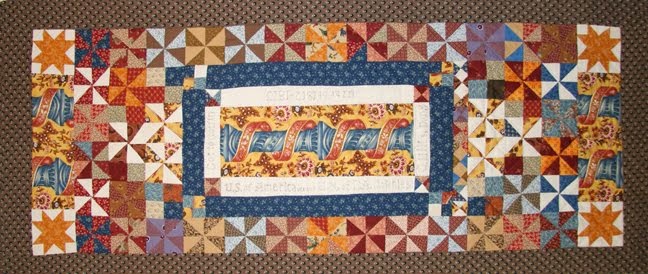A selection of the Great Lakes Seaway Trail War of 1812 quilts will be on display as part of our exhibit at the upcoming Fourth Annual War of 1812 Symposium in Ogdensburg, NY on April 27-28, 2012. We will also have a preview of some of our new War of 1812 theme interpretive panels on exhibit.
For all the details and to register for the event visit the Fort La Presentation website at: www.fort1749.org
Stop by and say hello at our booth at the Freight House Restaurant on Saturday.
The events seminars and presenters include:
Research leading to the discovery of Col. Zebulon Pike's encampment on the Saranac River Grab Island Plattsburgh
The archaeology confirming the site of Col. Zebulon Pike's encampment on the Saranac River : Timothy Abel, PhD, has interests spanning the prehistoric and early historic archaeology of the Great Lakes . Since 2003, he has conducted more than a dozen projects related to the military and domestic archaeology of the War of 1812 in northern New York Plattsburgh Jefferson Community College in Watertown , New York
Medical practices during the War of 1812: Gregory Baran, MD, a private practitioner and medical consultant in Kingston , Ontario Upper Canada Village
The discovery, investigation and the preservation of the Schooners Hamilton and the Scourge: Nancy Binnie, MSc, is a Senior Conservation Scientist with Canadian Conservation Institute in Ottawa , Ontario Hamilton Lake Charron in northern Manitoba , and the search for Avro Arrow models in Lake Ontario
The Battle of Queenston Heights and the role of Fort George in the War of 1812: Ronald Dale served as the Superintendent of Niagara National Historic Sites, including Fort George Niagara-on-the-Lake , Ontario
Planning for and conducting of War in North America, 1808-1815: Major John Grodzinski is an assistant professor of history at the Royal Military College of Canada in Kingston , Ontario Upper St Lawrence River . Since joining the army in 1983, he has held several appointments with his regiment, Lord Strathcona’s Horse, and various staff positions. Major Grodzinski conducts War of 1812 battlefield tours for the Canadian military. (Featured in the PBS War of 1812 production.)
Teaching the War of 1812 as a civil war: Melissane Schrems, PhD, is an assistant professor of history at St. Lawrence University in Canton , New York Cape Cod , and her minor fields were Native American history, the history of Colonial America and Comparative Slavery. She is on the board of the Fort La Présentation Association.
Abbé Piquet and the legacy of Indigenous/Mohawk alliances during the War of 1812: Scott Stevens, PhD, is the Director of the Newberry Library’s D’Arcy McNickle Center for American Indian and Indigenous Studies in Chicago

